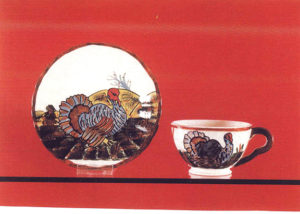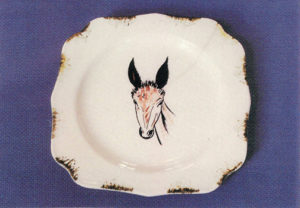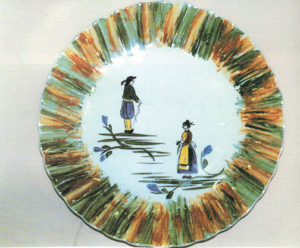 By Maureen Timm
By Maureen Timm Blue Ridge dinnerware acquired its name from the misty Blue Ridge Mountains in Tennessee. This charming, hand painted pottery decorated in a spectrum of vivid colors was one of the nation’s most attractive and original dinnerware lines for over forty years.
It all began in 1917 in the small southern town of Erwin, Tennessee, when the California Clinchfield and Ohio Railroad purchased land and established a pottery in an effort to promote industry along its line.
Erwin was an ideal location because of the availability of white kaolin clay and feldspar, two of the main ingredients for pottery making. Workers for the new plant were recruited from East Liverpool, Sebring, Ohio and Chester, Virginia.
In 1920 J.E. Owens purchased the pottery and received a charter for Southern Potteries, Inc. After a couple of years the plant was purchased by Charles W. Foreman who introduced the technique of hand painting under glaze. This was done freehand by applying a metallic base color with sponge or brush to the bisque ware before glazing. In 1938 Southern Potteries had evolved to full hand painting and Blue Ridge “Hand Painted Under the Glaze” dinnerware was born.
Blue Ridge’s fresh, uninhibited approach to design and their bold, bright colors was a welcome innovation and success. A large national sales organization was maintained with eleven showrooms in carefully chosen cities, including Chicago’s Merchandise Mart and an exclusive Fifth Avenue location in New York City. This organization, and extensive advertising made Blue Ridge one of the nation’s most popular dinnerware for many years.
 The decorating shop foreman taught the local women the basic folk painting strokes. Most patterns were free hand, copied from a master pattern and most of the patterns originated at the plant. Lena Watts, an Erwin native, was chief designer. She had a special flair for design and an eye for color and combined these talents with her love of the surrounding mountains and local landscapes. Her scenic plates depicting lonely cabins, mills and farm scenes are superb examples of folk art.
The decorating shop foreman taught the local women the basic folk painting strokes. Most patterns were free hand, copied from a master pattern and most of the patterns originated at the plant. Lena Watts, an Erwin native, was chief designer. She had a special flair for design and an eye for color and combined these talents with her love of the surrounding mountains and local landscapes. Her scenic plates depicting lonely cabins, mills and farm scenes are superb examples of folk art. During the mid 1940s a few of the outstanding artists were selected to paint a limited number of scenic and wildlife patterns on plates and large platters. They are signed with the artist’s name on the lower right hand comer. The plate designs are “Quail,” “Flower Cabin,” “White Mill,” “Gold Cabin,” “Turkey Gobbler,” and “Turkey Hen.”
In 1947 Stanley Home Products ordered a set of ivy decorated dinnerware as a hostess gift or premium for having a Stanley home party.
Blue Ridge items were also offered by leading trading stamp companies and in the mid 1950s, some Montgomery Ward stores gave a set of Blue Ridge dinnerware as a gift with the purchase of a dinette set. Some supermarkets gave their customers Blue Ridge dishes with a minimum amount of groceries purchased. A line of china character jugs was introduced in the 1950s and the workmanship and decorating is considered outstanding. Included in the line were the “Pioneer Woman,” “Daniel Boone,” “Paul Revere,” and the “Indian.” The jugs have personality and charm and are highly prized by collectors.
 Between 1950 and 1952 an idea was devised to produce several coordinating wallpaper and chinaware patterns. This idea did not prove successful and was abandoned after a short period of time. The five patterns, “Cherry Time,” “Woodbine,” “Wild Strawberry,” “Yorktown,” and “Blossom Tree,” are considered rare as very few pieces were made.
Between 1950 and 1952 an idea was devised to produce several coordinating wallpaper and chinaware patterns. This idea did not prove successful and was abandoned after a short period of time. The five patterns, “Cherry Time,” “Woodbine,” “Wild Strawberry,” “Yorktown,” and “Blossom Tree,” are considered rare as very few pieces were made. During the late 1940s glass tumblers, juices, and dessert cups, painted to match Blue Ridge patterns, were available from Montgomery Ward and Sears Roebuck. The main pieces available were 12 ounce tumblers, 5 ounce juices and dessert cups in the following patterns: “Ridge Daisy,” “Petal Point,” “Ridge Harvest,” “Mountain Ivy,” “Sun Bouquet,” “Green Briar,” “Crab Apple” and “Cumberland.”
Blue Ridge dinnerware was manufactured in the following twelve shapes: Candlewick beaded edge, Colonial fluted shape, Skyline sleek and plain, Trailway wide borders, Astor cupped rim, Piecrust crimped edge, Clinchfield wide, flat, Woodcrest textured, Monticello waffle, Modeme holloware, Trailway rope handled holloware and Palisades sleek & futuristic.
Among the most popular patterns and forms are those made in the 1940s. Round candy boxes, powder boxes and cigarette boxes were made in many different patterns. One of the most popular is the “Sherman Lily Box” a favorite with collectors.
Fine quality chinaware was introduced in 1945. These included pitchers, teapots, chocolate pots, coffee pots, creamers, sugars, vases, relish dishes and character jugs. Chocolate pots were designed with a matching tray and demitasse cups and saucers.
Teapots were made in earthenware decorated to match dinnerware sets and also in china with individual decorations. Pitchers were a popular item and were made in china and earthenware.
In 1947 Avon gave a set of “County Fair” salad plates to salespeople who sold an order of up to $200. Only the 8 1/2″ plates were used by Avon for their premium. These plates were manufactured in several different patterns and are prized by collectors.
Around 1945, a line of about forty pieces of fine quality vitreous chinaware was introduced. These included decorative pitchers, shakers, creamers and sugars, chocolate pots, teapots, vases, relish trays and character jugs. Teapots were made in earthenware and china in several different patterns.
Considerable national advertising was done from 1940 through 1956. Ads for Blue Ridge Dinnerware could be found in leading home magazines such as Better Homes & Gardens, House & Garden, American Home and House Beautiful.
The name “Blue Ridge” was introduced about 1932 and most of the company records have disappeared. It is impossible to obtain firm dates as to when various marks were used. The “Blue Ridge China” (5) mark was used after 1945. The marks bearing the words “detergent proof’ and “oven safe” (7, 8, 9) were used in later years. The marks used most often are the #4 scriptmark and the #6 circle mark using the Blue Ridge Mountains motif with the Lonesome Pine in the foreground.
The natural resources and creative talents of the Tennessee people have given the world a lovely example of folk art which can be enjoyed today.















Follow Us